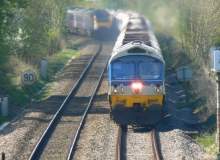
Following a winter of discontent on the rails, in which UK passengers fell victim to record snowfall and freezing temperatures as the nation’s transport network ground to a halt, the last thing to be considered was the possibility of it being too hot to travel.
Their worst fears were compounded, however, when a late-June heat wave sent both temperatures and passenger frustration soaring.
At the height of the heat wave on Monday June 27, temperatures in and around London reached 32ºC with the humidity factor significantly contributing to the scorching conditions. The soaring temperatures caused cables to sag and, in some cases, collapse completely.
With trains operating under enforced speed restrictions due to safety concerns, cancellations and delays of up to two hours became common place.
Cables collapsed at Bethnal green and Hockley stations, whereas speed limits were slashed from 90mph to 60mph in an effort to prevent further cable collapses.
Passengers caught in the disruption, many being held in trains without air-conditioning in the heat, vented their frustration.
Trackside temperatures prove problematic
Network rail reported trackside temperatures of up to 75ºC in certain areas, causing significant heating of overhead cables. Problems arose when the cables, dating back to the 1940s and 1950s in some locations, lost tension due to the heat.
Criticism did, however, continue to mount with RMT leader Bob Crow saying: "If money ripped off by train operators had been invested where it matters, we wouldn’t be reduced to this sort of chaos as the temperatures warm up."
Ipswich MP Ben Gummer echoed Crow’s complaints and has since voiced his concerns regarding the infrastructure to UK transport secretary Philip Hammond, commenting: "We have not had the investment that we need in the railway line for decades it’s about time we have our fair share of the cake."
Network Rail responded at the time, citing that the rail links most seriously impacted upon by the inclement weather were in the middle of a £200m upgrade to prevent cable sagging from happening in such temperatures. New cables were being installed and fitted with tension adjusters that mediate tension automatically, preventing sagging or hogging.
Tension in the carriages, not on the line
National Express East Anglia, the current operator of the routes in question, running into London Liverpool Street, placed the blame solely on the outdated equipment that was not adapted to function in such weather.
The catenary wires used to power rail lines are kept at a mechanical tension because the pantograph, the hinged device used to collect electricity from the power supply, causes oscillations in the wire. The wave must travel faster than the train in order to avoid producing standing waves which could cause wire breakage.
For low speed trains, as well as in areas where temperatures are generally constant, fixed termination equipment can be used with cables fixed directly onto structures at each end of the line.
Although the tension is generally about 10kN, the cables are suspect to deviations in tension owing to temperature parameters. In hot temperatures, the cables will sag and in colder temperatures, the cables will hog.
A fixed solution
A possible solution for overhead power lines that are prone to sagging or hogging in extreme temperatures is the use of auto-tensioning or constant tension, ensuring the tension in the cable is kept constant and unaffected by temperature deviations.
This can be achieved through the use of either a set of weights or hydraulic tensioners installed at specific points across the line, determined by the maximum length of continuous overhead line. Most overhead lines in the UK operate at 25kV, equating to a maximum tension length of 1970 metres.
A separate operational issue relates to the use of balance weights at both anchors, leading to the entire tension length being able to move along the track.
This can be circumvented through the use of a midpoint anchor installed close to the centre of tension length which serves to restrict the movement of the messenger wire.
Midpoint anchors can be attached to bridges or anchored through vertical catenary poles, allowing the contact wire and suspension hangers to only move within the constraints of the anchor point.
Impact on the lines
In the immediate aftermath of the disruption, eyes were cast towards the upcoming 2012 Olympic Games and any possible future disruptions which could occur should similar weather conditions strike as the event took place.
Network Rail’s plan to replace the outdated cables, a five-year plan that commenced in 2009, is expected to continue into 2014, though areas surrounding London and the Olympic site at Stratford were prioritised.
Following a review, National Express East Anglia and Network Rail, which is responsible for the infrastructure upon which NXEA trains function, deemed additional engineering work upon the afflicted lines necessary. Overhead power lines in the Maryland area were subsequently improved during engineering work in mid-August.
NXEA managing director Andrew Chives confirmed in a statement that: "Network Rail are currently upgrading all the overhead power lines between London and Chelmsford and we continue to work closely with them to ensure this vital upgrade is completed as quickly as possible."



